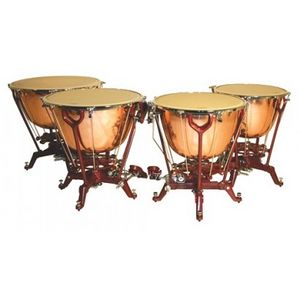Percussion History
 Range of Timpani | |
 | |
| Timpani | |
|---|---|
| Range of Timpani |
History Introduction - Type here
Antiquity (c. 200,000 B.C.) to Medieval (c. 1100 A.D.)
The Paleolithic Era
Fossil and Archaeological evidence shows us that humans began appearing in the eastern regions of Africa, specifically in the regions near present-day Kenya. (c. 198,000 B.C.) Almost as soon as humans began to spread into the jungles and seas surrounding Africa, primitive music began to develop. Body percussion was the apex form of instrumentation during the beginning years of man. However, striking one’s body to create ‘music’ was not the intention, there was no connection to striking the body to producing a sound to be appreciated. This however was short-lived, using body percussion assisted in the hunt, dancing and rituals, and soon became important in primitive East African culture, it still was taken seriously, and not used as a recreational outlet, such as for entertainment purposes.1 As human ideologies developed, they began to strike other objects. Sticks were important, as well as stones, especially when it came to testing sounds. One of the earliest human societies, the Zulu, were known to beat their shields and hunting bows in times of battle, a trait that would be used by civilizations throughout the world. Striking objects in order to obtain a specific sound slowly began to incorporate itself into the culture of the area, using objects that have been made for other purposes, such as bows and shields for battle, began to replace body percussion. After a successful hunt, a hunter would place the bows in front of him with the string facing him, and strike the string to assist in the rhythm of the victory dances for a successful hunt. As stones and sticks would become more involved in societies to create tools, early man of the Paleolithic Era (c. 198,000 B.C. – 10,000 B.C.) would begin looking for objects that resonated. Having this goal in mind, man began to discover idiophones, an object that vibrates when struck to produce a sound. These idiophones would be shaken, stamped, scraped, struck, or struck together (concussion). These included, but were not limited to: Proto-Claves, Xylophones, Wood Blocks, Rattles, Rubbed Shells, Scrapers, Stamped Pits, and Proto-Cymbals (Stone). Most if not all of these instruments, were created from wood, or the flora and fauna around the primitive societies. These instruments would comprise the Early Strata Instruments of the Paleolithic Era of the Stone Age.
Medieval (476 A.D.) to Classical (c. 1750)
Text Text TExt
Early Romantic Era (c. 1800 - 1910)
text Text Text
Late Romantic (c. 1900) to Early Modern (c. 1950)
text Text Text
Early Modern (c. 1950 - 1980)
text text text
The Modern Era (c. 1970 - 2017)
text text text
References